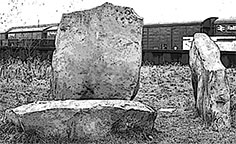- Screen Colours:
- Normal
- Black & Yellow
As Secretary of GeoSuffolk, I am responsible for Suffolk’s County Geodiversity Sites and recently checked the Ipswich Local Plan for its inclusion of the three CGS within the Borough. Although not immediately obvious, Ipswich has two distinctive geological features – its sarsen stones and its springs – and GeoSuffolk has designated the best examples of these in publicly accessible spots.
 Stoke Pocket Park CGS
Stoke Pocket Park CGS
The big stones or sarsens, found beneath our covering of sands, gravel and clay, are extremely hard sandstones of Tertiary origin (about 55 million years old). They have been much prized for their durability in this area of soft rocks. Thus, they are often found in church towers as for example St Nicholas Church and Wherstead Church. A large number were dredged from the Gipping near Stoke Bridge during work on the flood protection scheme in 1975 and soon thereafter the Pocket Park was created by the Ipswich Society*, with standing sarsens arranged by sculptor Bernard Reynolds. These are in three groups, one on Stoke Bridge and two along the river path, with a particularly fine large stone in the furthest group defaced by graffiti.
Christchurch Park CGS
The rockery in the Lower Arboretum of Christchurch Park is also made from sarsen stones believed to be from the 19th century dock basin excavations. The distinctive mamillated (rounded) surfaces of many of these stones shows well here. Further areas of the Christchurch Park CGS showcase Ipswich’s natural springs, so important in its early history. In the area immediately to the north of the Wilderness Pond a crag spring gives rise to a small stream, running into the pond and creating an area of water meadow. Seepages in the area between the Wilderness Pond and the Round Pond create wet footpaths and soggy grass in winter and havens for wildlife in summer. It is the unique (to the South Suffolk/North Essex coastal area) juxtaposition of permeable Red Crag on top of impermeable London Clay which gives rise to these springs with water seeping (or in wet weather pouring) out at the junction.
Holywells Park CGS
Crag springs are much in evidence in Holywells Park and play an important part in its history and natural history. The feeder spring for the landscaped ponds gushes out of Red Crag at the Nacton Road end of the park and also provides a water supply for the canal along the west border which channelled water to the Cobbold brewery nearby. On the south side of the park there are many springs and seepage areas, still mostly natural, which help to support the abundant and varied wildlife which thrives here.
Caroline Markham
(*P. Underwood (1999) The Sarsen Stones, Ipswich Society Newsletter, Issue 137 October 1999.)
Image based on a photograph of the Sarsen stones from the Ipswich Society Image Archive.